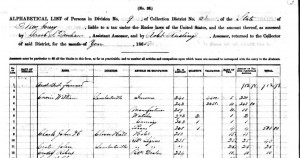Sometimes you stumble upon a source of information that just knocks your socks off. This is one.
I was researching some names in the Holcombe-Riverview cemetery north of Lambertville when Ancestry.com gave me a glimpse of this amazing source of information of which I was heretofore unaware. For learning about mid-19th century New Jersey residents, this just can’t be beat. I’m talking about the Civil War tax assessment lists that the National Archives have allowed Ancestry.com to digitize. Here’s a sample page:

Click on the picture to get a better view. It shows taxable items like watches, carriages and pianos, and occupations like retail dealer (storekeeper), hotel owner, retail seller of liquor. There were many more occupations than these that were taxed, like auctioneer, butcher, insurance claims agent, lawyer, physician, etc.
I have been looking at Collection District 3, which covers western New Jersey. (Eastern NJ seems to be in District 5.) The Collection Districts were divided into, what else? divisions. Southern Hunterdon County can be found in Divisions 7, 8 and 9. The locations listed are villages rather than townships, which makes me think that people’s locations are based on the post offices they used. Ringoes, for instance, turns up in two divisions, as does Lambertville.
The other fascinating thing about these lists is the occupations and possessions that were taxed. They give us real insight to the lives these people lived. And also, based on a glimpse of the tax list for a more urban area surrounding New Brunswick, people got taxed differently depending on where they lived. Near New Brunswick, you got taxed on candles, soap, clothing–all sorts of things that did not get taxed in Hunterdon. There must be a story behind that.
In fact, I hope to write an article about it in the future. In the meantime, I wanted to make my readers aware of it. As it turns out, I’m not the only one. Just this morning, I saw an article posted on the Archives website “NARAtions” titled “Family Tree Friday: More on Tax Records at the National Archives” by Katherine [Katherine who?]. She discusses the sorts of things that were taxed in Washington DC in 1863, and, just as with New Brunswick, some things were taxed that don’t show up in rural Hunterdon. No one in Hunterdon was taxed on renting rooms. Sociologists are going to love this.
Jerseyman
October 30, 2010 @ 8:24 pm
Marfy:
The IRS Civil War assessment records are an incredible source for the period during the belligerence and one year beyond. As you suggest, the socio-economic value of this material is incomparable for the time span the records cover. In the past, I have expended many hours delving into this source material long before Ancestry.com scanned and indexed it. Some years ago I informed my late friend, Carter Litchfield, of the research value contained within the assessment records and he gleaned much information about linseed oil production in New Jersey while rolling through the microfilm at 201 Varick Street in New York. A year or two after that, I introduced Gary Saretzky to the source and he added many more heretofore unknown photographers to his database of nineteenth-century New Jersey practitioners. There are many different approaches you can take to these primary-source documents and I am amazed that more people have not availed themselves of the material—particularly those who are conducting research into subjects related to commercial and industrial activities.
Best regards,
Jerseyman